
 Greenville County Parks, Recreation and Tourism has been looking for an effective method to maintain our paved trail surfaces for quite some time. We knew this need would become even more acute once we built the Greenville Health System Swamp Rabbit Trail (GHS Swamp Rabbit Trail), a 19.9-mile-and-growing multiuse greenway system that connects Greenville County with schools, parks and local businesses.
Greenville County Parks, Recreation and Tourism has been looking for an effective method to maintain our paved trail surfaces for quite some time. We knew this need would become even more acute once we built the Greenville Health System Swamp Rabbit Trail (GHS Swamp Rabbit Trail), a 19.9-mile-and-growing multiuse greenway system that connects Greenville County with schools, parks and local businesses.
In 2009, we opened the GHS Swamp Rabbit Trail, our first greenway trail/linear park. Originally 4 miles long, it has grown to 19.9 miles long and, annually, sees more than a half-a-million users and brings in $6.7 million in tourism revenue. Because of the scenic and shaded design of the trail, we noticed that it started to experience wear on the asphalt surface, from potholes caused by subsurface sinking to uplift from tree roots. What was needed was a compact asphalt repair unit that our passionate but small maintenance crew could manage. Last year, we found such a system in the infrared asphalt repair process produced by KM International.
Prior to discovering the infrared repair process, we literally had to beg to get on the road paving list of the County Roads and Bridges crew, a list that was always long! In addition to the long wait, the traditional method of repaving includes several steps that can prove to be problematic for trails. Following are a few of the challenges we encountered:
Traditional repaving involves large heavy trucks. Our pavement is only 2 inches thick. The use of heavy trucks can leave tire depressions and can be especially damaging to our trail shoulders, causing "gator cracking" that has the potential to catch tires and cause trail users to be thrown down as fast as a gator closing its jaws.
Traditional repaving equipment is about as wide as our trail. Our GHS Swamp Rabbit Trail — so named because it’s on an old rail bed that runs through some swampy areas that were once home to Sylvilagus aquaticus or Swamp Rabbits — is mostly 10 feet wide. Usually, when a road is being repaired, a detour is created to allow vehicles to drive around the work. On our trail, we do not have that option. We can’t have a mom with baby in a bike trailer or small children just learning to ride make a detour off the trail and ride on a roadway with a 45-mile-per-hour speed limit as we repair a section of trail.
Asphalt is typically only made when the temperature is 50 degrees and rising. When the temperature reaches 50 degrees and higher, people really like to be out on the trail.
Traditional milling and repair removes all existing asphalt and has to bring in all new material to make a patch. This method of repair creates a seam for freeze-thaw damage and for weeds to grow. It also isn’t very environmentally friendly to haul usable asphalt offsite when it could be reused on-site.
The infrared asphalt repair technology and process allows us to work on half the width of the trail while the other half stays open and passable for trail users. A two-man crew using equipment hauled behind a Gator can heat up a 42-inch by 42-inch work area in seven minutes, allowing the crew to dig down and remove a root. Then, working with the existing asphalt and a just a few new asphalt bricks to fill in the space created by the root removal, the crew can make a repair that is thermally bonded to the surrounding asphalt — no seam, no trail closure, no detour and, no sitting on a long county waiting list!
The reality for many park and recreation agencies is that we have employees that have pride in their parks and community members that thirst for more recreation, but we never have enough money or time to meet all needs. We are excited that with a small investment, we now have technology that allows us to more effectively and efficiently maintain our trails. During the time of year when we aren’t cutting grass, marking fields or spending extra time cleaning up, and, more importantly, when trail usage is not at its highest, we can spend time working on our trails. This technology allows us to carry out repair work in colder temperatures, even below freezing and in the snow (conditions that are not traditionally ideal for asphalt repair), when we have “more time” for projects like these. In fact, we are preparing to use the infrared asphalt equipment one week a month in January, February and March of 2017.
Ty Houck is the Director of Greenways, Natural and Historic Resources at Greenville County Parks, Recreation and Tourism in South Carolina.

